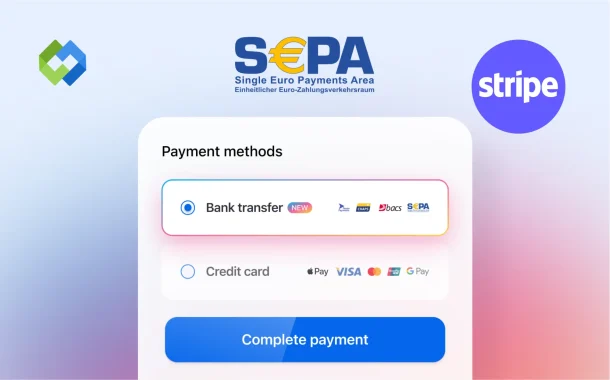With Stripe, you can easily add SEPA as a payment option on your site. Customers just enter their IBAN to authorize the payment. Once approved, the money is transferred securely. Stripe handles the full process, including verification and timing.
Table of Contents
Table of Contents
How Stripe Supports SEPA Direct Debit
Stripe supports SEPA Direct Debit by allowing businesses to collect payments straight from their customer’s bank accounts. It’s designed for companies that want to accept euro payments in the SEPA zone. This payment method is great for both one-time and recurring charges. Customers only need to enter their IBAN to approve the transaction.
Stripe handles the entire process behind the scenes. It takes care of storing authorization, sending the debit request to the customer’s bank, and managing the payment flow. You don’t need to deal with banks directly or set up any special contracts. Stripe makes it easy through its dashboard and API.
Once the customer gives approval, Stripe pulls the funds and sends them to your Stripe balance. This process takes a few days, and you’ll be updated about the payment status. If the payment fails or gets disputed, Stripe informs you immediately.
SEPA Direct Debit is safe, cost-effective, and trusted across Europe. Stripe adds an extra layer of convenience by managing compliance, timing, and user authorization. It helps businesses grow in Europe while cutting down on card-related fees.
Steps to Enable SEPA on Stripe
- Check Account Eligibility: Make sure your Stripe account is based in a SEPA-supported country and can process payments in euros. SEPA is only available for businesses operating in certain regions.
- Enable SEPA Direct Debit in Settings: Log in to your Stripe dashboard. Go to Settings > Payment Methods. Find SEPA Direct Debit and click Enable. Stripe may ask for business details, bank info, or additional verification.
- Integrate SEPA into Your Checkout: Use Stripe Checkout or Payment Element to accept SEPA payments. These tools automatically support SEPA and handle the user interface. For advanced control, use the Stripe API to create a custom flow.
- Collect IBAN and Get Authorization: Customers need to enter their IBAN and authorize the payment. Stripe stores the mandate (approval) and handles all required compliance steps.
- Start Accepting Payments: Once setup is complete, you can start receiving SEPA payments. Stripe will notify you of the status of each payment. Everything from collection to dispute handling is managed automatically through your dashboard.
Customer Authorization and Payment Flow
IBAN Collection from the Customer
The SEPA payment flow starts when a customer selects SEPA Direct Debit at checkout. They must enter their IBAN (International Bank Account Number). This is the main detail needed to initiate the debit from their bank account.
Mandate Authorization
After entering the IBAN, the customer must authorize a mandate. This is a legal agreement allowing you to debit their account. Stripe automatically handles this step by generating and storing the mandate. The customer sees the mandate terms before confirming.
Stripe Initiates the Debit
Once authorized, Stripe schedules the debit from the customer’s account. This typically happens within 1 to 2 business days, but the full processing time can take up to 5 business days depending on the bank.
Payment Confirmation and Updates
Stripe updates the payment status in your dashboard. You’ll see if the payment is processing, successful, failed, or returned. If a payment fails, Stripe also handles notifications and flags it for your review.
Processing Time and Payout Schedule
SEPA Payment Processing Time
SEPA Direct Debit payments are not instant. Once a customer authorizes a payment, Stripe sends the debit request to their bank. It usually takes 1 to 2 business days to initiate and up to 5 business days for the full process to complete. This delay is due to bank processing rules across the SEPA zone.
Confirmation and Settlement
During this time, the payment status in your Stripe dashboard will show as pending. After the funds are successfully pulled, the payment is marked as succeeded. If the bank rejects the debit (due to insufficient funds or wrong IBAN), Stripe flags it as failed or returned.
Payout Schedule
Stripe adds SEPA funds to your available balance after the payment clears. The payout schedule depends on your country and account settings, but typically, it takes a few extra days after the payment is successful. You can view exact payout timelines in your dashboard under the Payouts section.
Fees and Supported Countries
Stripe SEPA Direct Debit Fees
Stripe charges a flat fee for SEPA Direct Debit payments. As of now, the standard fee is 0.35€ per successful transaction. There are no percentage-based charges like with card payments. This makes SEPA a cost-effective option, especially for larger payments or recurring billing.
No Setup or Monthly Fees
Stripe does not charge any setup, monthly, or hidden fees to enable SEPA. You only pay per successful transaction. However, keep in mind that returned or disputed payments may involve additional charges depending on your agreement with Stripe.
Supported Countries
SEPA Direct Debit is available to businesses operating in SEPA zone countries. This includes all EU countries, along with others like Norway, Switzerland, Iceland, and the UK. Customers must also have a bank account in one of these countries and pay in euros (EUR). You can check full eligibility in Stripe’s documentation or dashboard.
Refunds, Disputes, and Chargebacks
Handling Refunds with SEPA
Stripe allows you to issue full or partial refunds for SEPA Direct Debit payments directly from your dashboard or through the API. Refunds can take up to 10 business days to process, depending on the customer’s bank. Once initiated, Stripe handles the transfer of funds back to the customer.
SEPA Dispute Window
Customers have the right to dispute a SEPA payment. They can file a dispute with their bank within 8 weeks for authorized payments and 13 months for unauthorized ones. During this period, the customer’s bank can reverse the payment without prior notice.
Stripe’s Role in Disputes
If a payment is disputed or returned, Stripe marks it as failed or disputed in your dashboard. The amount is deducted from your Stripe balance. Unlike card chargebacks, SEPA disputes do not include a formal review process through Stripe. You won’t have a chance to submit evidence.
Minimizing Risk
To avoid disputes, always ensure clear communication and obtain proper authorization. Stripe helps by storing signed mandates and giving updates on payment status. Using clear billing descriptions and contacting the customer in case of issues can also reduce risk.
Conclusion
Stripe SEPA Bank Transfer is a good option for businesses working in Europe. It lets you collect payments directly from customer bank accounts in euros. The setup is simple, and Stripe handles most of the process for you.
It’s cost-effective, secure, and trusted across many countries. With proper setup and clear customer communication, you can avoid most issues. SEPA is a smart choice if you want to expand in the EU market without high card fees.














